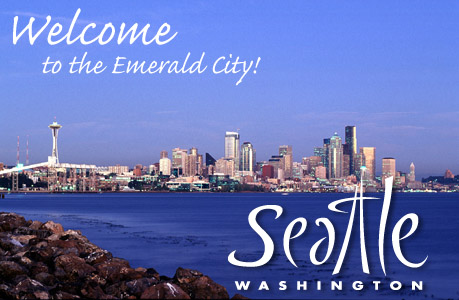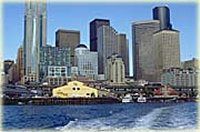|
|
|

Seattle is about 150 miles south of Vancouver on Puget Sound and is named after an indian chief. It is built on the side of a hill and is very uneven. A description we found was:
Steep hills, lush greenery, glimpses of sparkling water everywhere -- Puget Sound, bays, lakes, rivers, canals. And snow-capped Mount Rainier in the distance suddenly emerging from its mantle of clouds. We soon learned why Seattle is known as "The Emerald City."
Seattle is a welcoming place, even though the population of the city and the greater Puget Sound region is three million and growing. The natural boundaries of hills and water produce a city of neighbourhoods that feel like small towns, vibrant and intriguing. Every neighbourhood has its share of charms. Quirky or classic, there are limitless opportunities for discovery.
Perhaps the outstanding symbol of Seattle is the Space needle, built for the worlds fair in 1966 . The monorail from that connected the site to downtown still operates (although we did not travel on it)
We visited and dined at Pike Place Market downtown which is the oldest continually operating farmers market in the USA, which was saved from the wrecking ball of "progress" by public vote in 1971
Views of Seattle

Seattle has a long waterfront, formerly home to many ships (including those heading for the Klondike gold rush. The piers have now been converted to commercial premises, such as souvenirs shops and resturants. The picture shows it from Puget Sound, perhaps it's better side!
Pioneer Square is reputedly the birthplace of Seattle. There are a number of old buildings relating back to gold rush time. The term 'Skid row' originated here, as logs were slid down the hill to the mill here.
Lake Union, this is protected from Puget Sound by a seies of locks.
The 'floating' bridge over the lake. As there is no tide, it effectively floats on the water